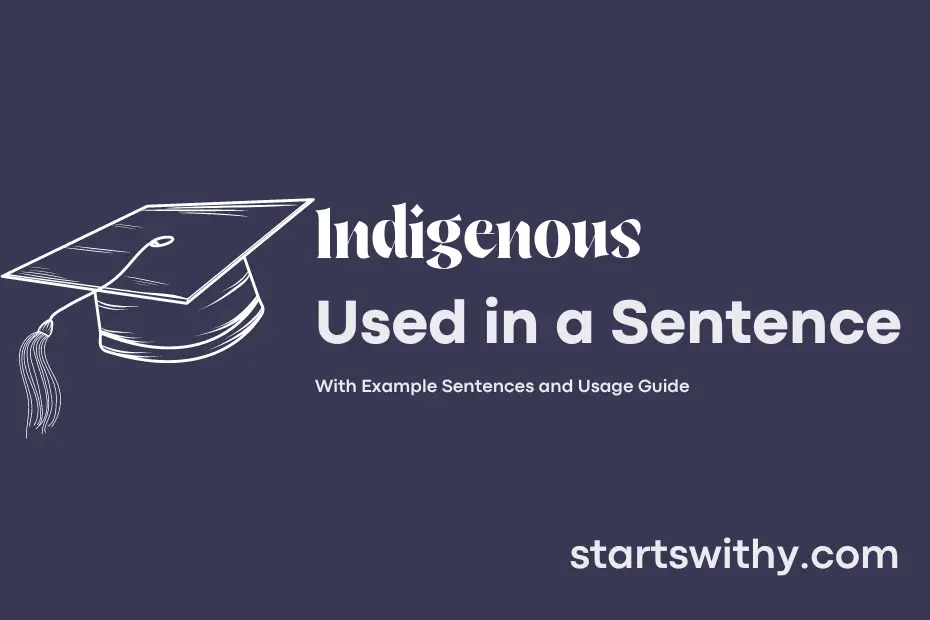Have you ever wondered what the term “indigenous” means and how it is used in various contexts? Indigenous refers to people or things that are native to a particular region, country, or habitat.
When discussing indigenous communities or cultures, we are referring to those that have existed in a specific area for generations and have a strong connection to the land, traditions, and customs of that region.
7 Examples Of Indigenous Used In a Sentence For Kids
- Indigenous animals are those that have always lived in a certain place.
- We can learn about indigenous cultures by listening to their stories and songs.
- The plants growing in our garden are indigenous to our country.
- The clothes people wear in different regions may be made from indigenous materials.
- A person’s language can be indigenous to their community or tribe.
- It is important to protect indigenous traditions and customs.
- We should respect and appreciate the indigenous people of our country.
14 Sentences with Indigenous Examples
- Indigenous tribes in India have a rich cultural heritage that is important to study as college students.
- Learning about the indigenous languages spoken in different regions of India can broaden our linguistic knowledge.
- It is essential for college students to understand the challenges faced by indigenous communities in India.
- As future leaders, it is our responsibility to support and advocate for the rights of indigenous people in India.
- Researching the sustainable practices of indigenous farmers in India can provide valuable insights for agriculture students.
- Exploring the traditional art forms of indigenous groups can inspire creativity and appreciation for diverse cultures.
- Engaging with indigenous literature and folklore can give college students a deeper understanding of India’s cultural diversity.
- Collaborating with indigenous artisans can help students learn about traditional craftsmanship and promote ethical sourcing practices.
- Understanding the historical perspective of indigenous movements in India is crucial for social science students.
- Indigenous knowledge systems have played a significant role in shaping India’s environmental practices and sustainability efforts.
- Encouraging dialogue and exchange between college students and indigenous elders can foster intergenerational learning and cultural preservation.
- Participating in indigenous festivals and celebrations can offer students a unique opportunity to experience India’s diverse cultural traditions.
- Supporting indigenous entrepreneurs and businesses can contribute to the economic empowerment of marginalized communities in India.
- Exploring the healthcare practices of indigenous tribes can provide valuable insights for medical students interested in holistic medicine.
How To Use Indigenous in Sentences?
When incorporating the word Indigenous into a sentence, it is important to remember its significance in referring to native peoples or things belonging to a particular place. Here is a guide on how to use Indigenous effectively:
-
Understand the meaning: Indigenous is used to describe people, animals, or plants that are native to a specific region or environment. It highlights the original inhabitants of a place.
-
Placement in a sentence: When using Indigenous, place it before the noun it describes. For example, “The Indigenous tribes of the Amazon rainforest have a deep connection to the land.”
-
Capitalization: Always capitalize Indigenous when referring to Indigenous peoples or communities out of respect for their cultural identity.
-
Avoid using possessive terms: When discussing Indigenous communities, it is best to avoid possessive terms like “their”, and instead focus on highlighting their autonomy and distinct culture.
-
Use specific terms: It is helpful to be specific when referring to Indigenous groups by including the name of the tribe or community, such as “The Maori are an Indigenous group in New Zealand.”
By following these guidelines, you can effectively use the word Indigenous in a respectful and accurate manner while acknowledging the history and culture of native communities.
Conclusion
In conclusion, the examples of sentences with ‘indigenous’ in this article illustrate various aspects of the indigenous communities, cultures, and rights. These sentences shed light on issues such as land disputes, preservation of heritage, and historical injustices faced by indigenous peoples. By examining these sentences, we can better understand the significance of respecting and celebrating the diversity and contributions of indigenous populations around the world.
Through these examples, it becomes evident that acknowledging the unique identities and experiences of indigenous groups is essential for promoting inclusion, equality, and social justice. By using language that respects and empowers indigenous communities, we can work towards creating a more equitable and harmonious society that values and protects the heritage and rights of all people, especially those who have been historically marginalized.



